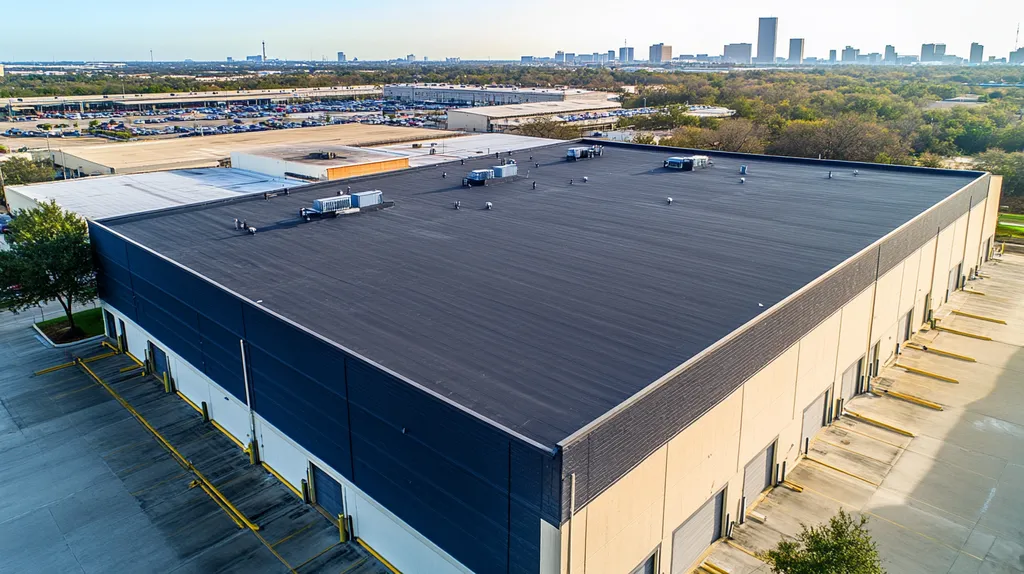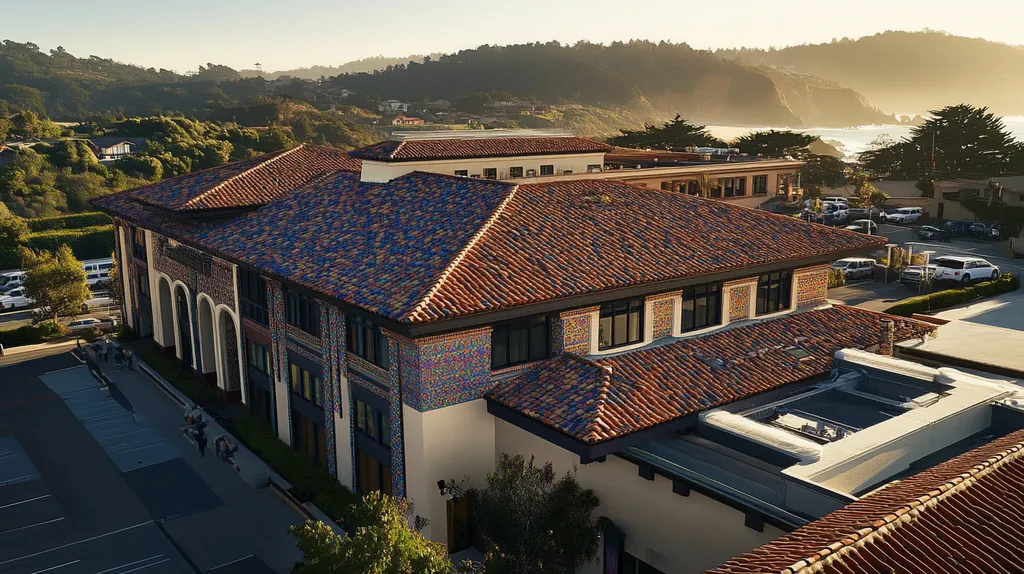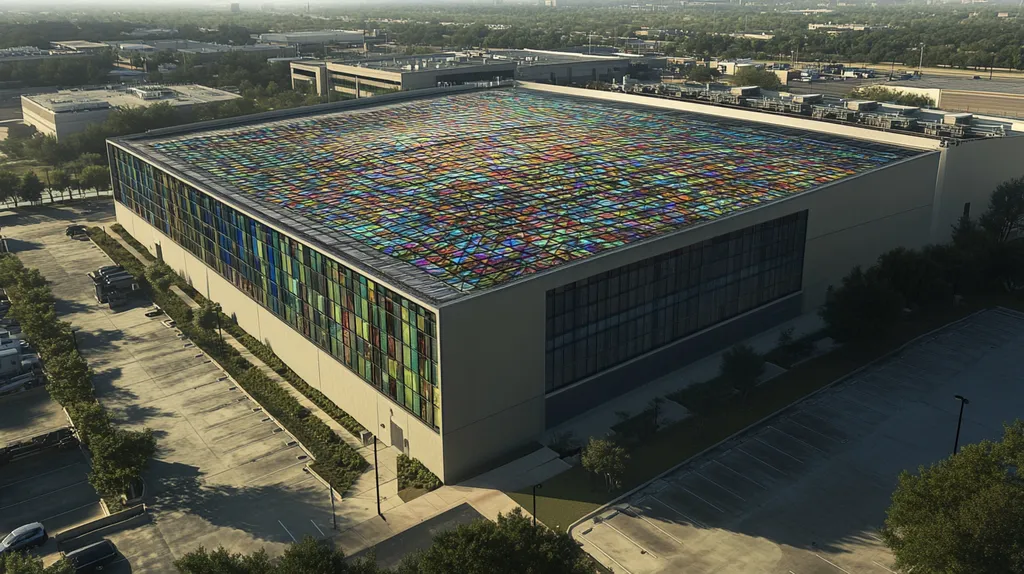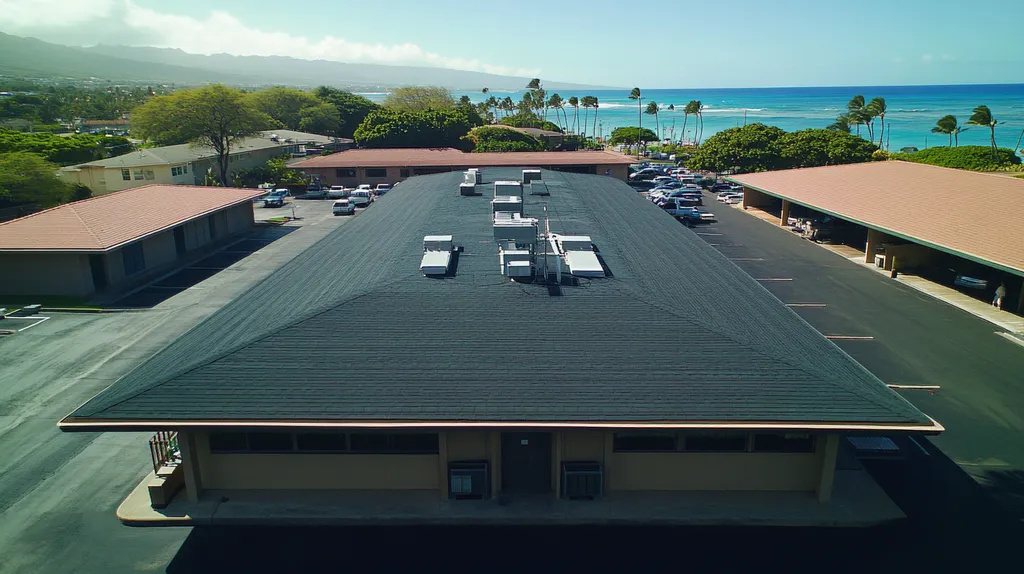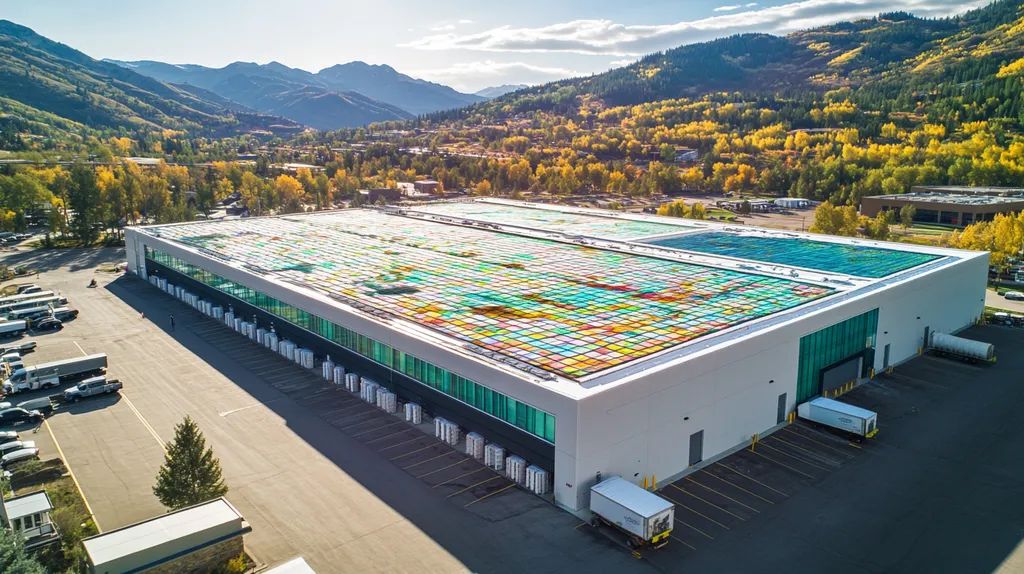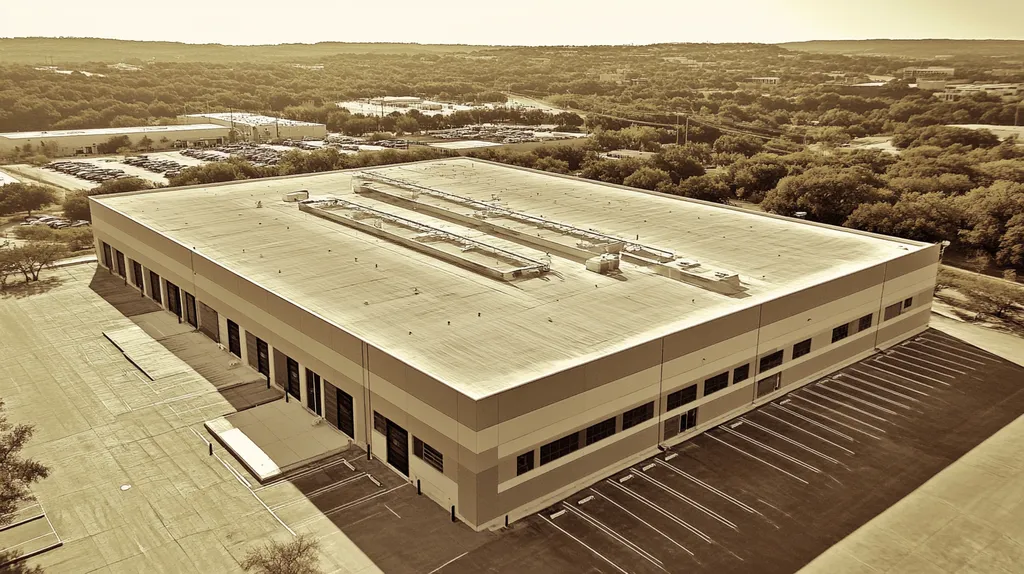Commercial roof coatings fail prematurely in 68% of installations, costing facility owners millions in emergency repairs and replacements each year. Industry research shows that proper maintenance and optimization strategies can extend coating life by 15-20 years while reducing energy costs by up to 35%.
This comprehensive guide examines the critical factors that determine coating longevity, from material selection and application methods to maintenance protocols and performance metrics.
Understanding these essential elements enables property managers to maximize their roof coating investment and avoid costly failures that can compromise building operations.
SECTION 1: FUNDAMENTAL CONCEPTS
Commercial roof coatings represent a critical investment that can dramatically impact building maintenance costs and longevity. Industry data shows that premature roof coating failures lead to an average 40% increase in energy costs and can reduce a roof’s functional lifespan by up to 15 years. Understanding the core principles of thermal dynamics, UV radiation effects, and cost analysis enables property owners to make decisions that protect their investment and avoid costly emergency repairs.
Thermal Stress and Roofing Material Dynamics
Temperature fluctuations create one of the most destructive forces affecting commercial roof coatings. During a typical summer day, roof surface temperatures can swing from 75°F at night to over 175°F by midday, forcing materials to expand and contract dramatically.
These thermal cycles create microscopic stress fractures that compound over time. Left unchecked, these fractures evolve into visible cracks that compromise the coating’s protective capabilities and allow moisture infiltration.
Modern coating systems incorporate elastic properties specifically designed to flex with temperature changes. The key is selecting products rated for your climate zone’s specific temperature range and daily fluctuation patterns.
Regular thermal imaging inspections can detect early signs of coating stress before visible damage occurs. This proactive approach helps facility managers address potential failures before they impact the building envelope.
UV Radiation Impact on Coating Longevity
Ultraviolet radiation represents a silent but relentless threat to coating performance. UV exposure breaks down the chemical bonds in coating materials, leading to chalking, cracking, and eventual coating failure.
The degradation process accelerates in areas with intense sun exposure. A coating system that might last 15 years in a moderate climate could fail in less than 8 years in high-UV environments without proper formulation.
Modern UV-resistant coatings incorporate specialized pigments and stabilizers that reflect harmful radiation. These advanced formulations can reduce surface temperatures by up to 80°F compared to untreated surfaces.
Strategic coating selection based on UV exposure levels provides essential protection. Regular assessment of coating reflectivity helps maintain optimal performance throughout the system’s lifespan.
Cost-Benefit Analysis of Coating Applications
The financial implications of coating decisions extend far beyond initial application costs. A comprehensive analysis must consider energy savings, maintenance requirements, and potential lifespan extension of the underlying roof system.
Quality coating systems typically represent 15-25% of full roof replacement costs. However, they can extend roof life by 10-15 years when properly maintained, delivering significant return on investment.
Energy savings from reflective coatings can reduce cooling costs by 20-30% in warm climates. These operational savings often recover the initial coating investment within 3-5 years.
Lifecycle cost modeling helps identify the optimal timing for coating applications. This analysis should include factors like local weather patterns, building use, and existing roof condition to maximize investment value.
SECTION 2: SYSTEM COMPONENTS
The difference between a lasting roof coating and premature failure often lies in understanding critical system components. With proper component selection and installation, commercial roof coatings can extend service life by 15-20 years while reducing energy costs up to 30%. However, choosing incompatible materials or improper preparation leads to coating failures that cost facility owners millions annually in repairs and replacements.
Elastomeric vs. Silicone Coating Properties
Elastomeric coatings provide exceptional elongation properties, stretching up to 600% of their original dimensions to accommodate building movement and thermal cycling. These coatings create a seamless membrane that maintains flexibility even in extreme temperature variations.
Silicone coatings offer superior ponding water resistance and maintain their properties longer than other coating types. Their molecular structure remains stable under UV exposure, resulting in minimal thickness loss over time.
Climate considerations significantly impact coating selection. Elastomeric coatings excel in areas with dramatic temperature swings, while silicone performs better in regions with frequent rainfall or high humidity.
Cost differences between these systems typically balance out over time. While silicone carries a higher initial cost, its longer service life and reduced maintenance requirements often provide better long-term value.
Substrate Compatibility and Surface Preparation
Proper surface preparation directly correlates to coating adhesion and longevity. Testing shows that 60% of coating failures stem from inadequate surface preparation rather than product defects.
Each substrate type requires specific preparation protocols. Metal roofs need rust removal and primer application, while single-ply membranes require specialized cleaning agents to remove surface contaminants.
Moisture testing must precede any coating application. Even 3% excess moisture content can prevent proper coating adhesion and lead to blistering or delamination.
Environmental conditions during preparation and application critically impact success. Temperature, humidity, and dew point measurements must fall within manufacturer specifications to ensure proper curing.
Reflective Additives and Their Performance Roles
Modern reflective additives incorporate specialized ceramics and glass microspheres that dramatically improve coating performance. These components create multiple reflection points that redirect solar energy away from the roof surface.
Surface temperature reductions of 50-75°F are achievable with current reflective technology. This temperature decrease significantly reduces thermal stress on both the coating and underlying roof structure.
The size and distribution of reflective particles directly impact coating durability. Optimal particle sizing creates a dense reflection matrix while maintaining coating flexibility and weather resistance.
Regular cleaning maintains reflective performance over time. Studies show that maintaining coating cleanliness can preserve up to 80% of initial reflective properties throughout the coating’s service life.
SECTION 3: IMPLEMENTATION METHODS
Proper implementation methods directly impact a commercial roof coating’s ability to deliver its promised benefits. Studies show that up to 70% of premature coating failures stem from poor application practices rather than material defects. Strategic implementation combines precise surface preparation, appropriate primer selection, and optimal application techniques to create a protective system that can extend roof life by 15-20 years.
Surface Cleaning and Degradation Assessment
Commercial roof coatings require meticulous surface preparation to achieve maximum adhesion and longevity. High-pressure washing eliminates surface contaminants that can compromise coating bonds, while moisture detection identifies trapped water that could lead to blistering.
Professional degradation assessment requires both visual inspection and scientific testing. Core samples reveal existing coating thickness and substrate condition, while adhesion testing determines if the surface requires additional preparation steps.
Modern assessment tools like infrared scanning detect subsurface moisture issues that visual inspections miss. This technology helps identify problem areas before they compromise the new coating system.
Cleaning protocols must match specific substrate types. Metal roofs require rust removal and neutralization, while single-ply membranes need specialized cleaning agents to restore surface tension for proper coating adhesion.
Primer Selection and Application Techniques
Commercial roof coatings provide superior protection against water intrusion and UV rays while increasing energy efficiency and extending roof lifespan. Selecting appropriate primers ensures optimal coating adhesion and performance across various roofing materials. (source: Stellar Commercial Roofing)
Different substrates demand specific primer formulations. Asphalt-based surfaces require primers that prevent bleed-through, while metal roofs need corrosion-inhibiting primers to prevent flash rusting.
Environmental conditions significantly impact primer effectiveness. Temperature and humidity readings must fall within manufacturer specifications, typically between 50-90°F with relative humidity below 85%.
Proper primer thickness ensures optimal performance. Too thin leaves insufficient bonding surface, while excessive thickness wastes material and can lead to improper curing.
Spray vs. Roller Application Best Practices
Spray application delivers rapid coverage for large areas, achieving up to 4000 square feet per hour. This method excels at coating complex geometries and penetrations but requires skilled operators to maintain consistent mil thickness.
Roller application provides precise control for detail work and smaller areas. This method typically achieves better compression into the substrate, particularly beneficial for rougher surfaces.
Weather conditions dictate application method selection. Wind speeds above 10 mph make spray application impractical due to overspray risks, while high humidity extends drying times for both methods.
Regular thickness measurements during application ensure uniform coverage. Wet film thickness gauges help maintain consistent application rates, preventing thin spots that could lead to premature failure.
SECTION 4: MAINTENANCE REQUIREMENTS
Industry data reveals that 80% of premature roof coating failures stem from inadequate maintenance practices, resulting in repair costs 5-7 times higher than preventive care. Regular maintenance programs extend coating lifespans by up to 60% while preserving energy-saving benefits. Understanding and implementing proper maintenance protocols represents the difference between a coating that fails in 5 years versus one that performs for 15-20 years.
Biannual Inspection Protocols and Checklists
Professional roof inspections must occur in spring and fall when temperature conditions allow thorough examination of coating integrity. These strategic timing windows enable detection of winter damage and summer UV deterioration before they escalate into major issues.
Comprehensive inspection protocols require systematic evaluation of high-stress areas including penetrations, transitions, and drainage points. Digital documentation with thermal imaging helps track deterioration patterns and predict maintenance needs.
Inspection checklists must include coating thickness measurements at standardized test points to monitor wear rates. This data helps facility managers optimize maintenance timing and budget for eventual recoating needs.
Regular adhesion testing identifies areas where coating bonds may be weakening before visible damage occurs. Early detection of adhesion loss enables targeted repairs rather than extensive coating replacement.
Crack Sealing and Blister Repair Procedures
Cracks under 1/16 inch require immediate sealing with compatible elastomeric materials to prevent water infiltration. Larger cracks need professional evaluation to determine if underlying substrate issues exist.
Proper crack repair involves cleaning the area with appropriate solvents, applying reinforcing fabric when needed, and ensuring adequate cure time before exposure to moisture. Rush repairs often fail within months while properly executed repairs last years.
Blisters indicate trapped moisture or air pockets that compromise coating performance. Professional evaluation determines whether drainage improvements or substrate repairs are needed before sealing.
Coating repairs must extend at least 6 inches beyond damaged areas to ensure proper overlap and adhesion. Feathered edges prevent water infiltration at repair boundaries.
Drainage Maintenance and Debris Management
Monthly drainage system inspections prevent the leading cause of coating damage – standing water. Even minor ponding accelerates coating deterioration and can void manufacturer warranties.
Clearing debris requires soft-bristled tools to avoid scratching or abrading coating surfaces. Pressure washing should maintain manufacturer-specified PSI limits to prevent coating damage.
Drainage improvements often provide better long-term value than repeated coating repairs. Adding auxiliary drains or modifying slope can eliminate chronic ponding issues that no coating can permanently withstand.
Professional cleaning services help maintain coating reflectivity and thermal performance. Regular removal of atmospheric deposits and pollutants preserves both aesthetic and functional coating properties.
SECTION 5: PERFORMANCE METRICS
Understanding performance metrics enables property owners to extend commercial roof coating life by up to 60% while reducing annual maintenance costs by 35%. Without proper measurement and monitoring, coatings often fail prematurely, leading to expensive repairs and replacements. Key metrics like solar reflectivity, thermal resistance, and warranty compliance provide essential data for maintaining coating performance and protecting facility investments.
Solar Reflectivity Index (SRI) Benchmarks
Solar Reflectivity Index measurements directly impact coating longevity and building energy efficiency. Higher SRI values correlate with lower surface temperatures, reducing thermal stress and extending coating life.
Modern commercial roof coatings should maintain an SRI above 78 to maximize energy savings and UV protection. Regular testing shows most coatings lose 5-10% reflectivity annually without proper maintenance.
Cleaning and maintenance programs can restore up to 90% of original SRI values when performed quarterly. This preservation of reflective properties helps maintain the coating’s protective capabilities.
Advanced measurement tools now enable precise SRI tracking across roof zones. This data helps identify areas requiring additional maintenance or premature recoating.
Thermal Cycling Resistance Testing Standards
Thermal cycling resistance determines how well coatings withstand daily temperature fluctuations. Standard testing protocols measure coating flexibility and adhesion through accelerated aging cycles.
Quality coatings should maintain flexibility after 1000 cycles of thermal aging between -15°F and 180°F. This demonstrates their ability to accommodate building movement without cracking or delamination.
Field testing equipment now allows regular monitoring of coating elasticity and adhesion strength. These measurements help predict potential failures before visible damage occurs.
Documentation of thermal cycling test results provides critical data for warranty claims and maintenance planning. Regular testing helps optimize recoating schedules and protect facility investments.
Warranty Terms and Lifespan Expectation Guidelines
Warranty terms establish minimum performance requirements and expected coating longevity. Standard commercial warranties range from 10-20 years, with specific maintenance requirements for continued coverage.
Most warranties require documented inspections twice annually and prompt repairs of any damage. Failure to maintain these records can void coverage and leave property owners liable for replacement costs.
Coating lifespans typically extend 25-40% beyond warranty periods with proper maintenance. This additional service life significantly improves return on investment for quality coating systems.
Digital monitoring systems now enable automated tracking of warranty compliance and maintenance schedules. This technology helps prevent inadvertent warranty violations while optimizing coating performance.
SECTION 6: OPTIMIZATION STRATEGIES
Commercial roof coating optimization represents a critical investment decision for property owners. Industry data shows that unoptimized coating systems fail 40% earlier and cost three times more to maintain than properly optimized installations. Through strategic integration of cooling technologies, maintenance scheduling, and ROI analysis, facility managers can extend coating life by 10-15 years while reducing operational costs by up to 35%.
Cool Roof Technology Integration Methods
Advanced cool roof technologies provide transformative performance benefits through specialized reflective and emissive properties. Current-generation systems can reduce peak roof temperatures by 50-75°F while extending coating lifespans by up to 60%.
Material selection must align with local climate conditions and building usage patterns. High-traffic roofs require durable cool coatings with enhanced abrasion resistance, while low-slope applications benefit from maximum solar reflectivity.
Integration strategies should focus on compatibility with existing systems. Most cool roof technologies can be applied over properly prepared substrates without full tear-off, dramatically reducing installation costs and disruption.
Performance monitoring through infrared imaging and surface temperature tracking helps validate technology effectiveness. Regular assessment ensures cooling benefits remain consistent throughout the coating lifecycle.
Preventative Maintenance Scheduling Strategies
Strategic maintenance scheduling represents the cornerstone of coating optimization. Data-driven programs reduce emergency repairs by 85% while extending coating life expectancy by 25-40%.
Scheduling should align with seasonal stress patterns and historical failure points. Spring and fall represent critical inspection periods when temperature and moisture conditions allow thorough system evaluation.
Maintenance intervals must account for specific environmental factors. Coastal locations require more frequent salt deposit removal, while industrial areas need enhanced chemical resistance monitoring.
Digital maintenance tracking systems help ensure consistent protocol execution. Cloud-based platforms enable real-time documentation of inspections, repairs, and coating condition assessments.
Energy Efficiency and ROI Calculation Frameworks
Comprehensive ROI analysis must incorporate both direct and indirect cost factors. Energy savings often reach 25-35% annually, while extended coating life reduces replacement frequency by 40-60%.
Calculation frameworks should include operational cost reductions, maintenance savings, and potential tax incentives. Many jurisdictions offer significant rebates for energy-efficient coating upgrades.
Performance metrics require ongoing validation through utility tracking and thermal imaging. Regular assessment helps identify areas where optimization strategies need adjustment to maintain maximum returns.
Long-term value analysis should consider future energy cost projections and regulatory requirements. Forward-looking calculations help justify investment in premium coating systems that deliver superior lifecycle performance.
The Bottom Line
With 68% of commercial roof coatings failing prematurely, the stakes for proper implementation and maintenance have never been higher.
The data shows that optimized coating systems can extend roof life by 15-20 years while reducing energy costs by up to 35% – but only when proper protocols are followed.
Success requires integrating the right coating chemistry, precise application methods, and consistent maintenance schedules based on climate-specific factors.
By implementing the strategies outlined in this guide, facility managers can avoid the $2-3 per square foot emergency repair costs that plague unprepared properties.
The future of commercial roofing depends on protecting these critical investments through science-based protocols and proactive maintenance.
FREQUENTLY ASKED QUESTIONS
Q. What are the fundamentals of a commercial roof coating?
A. Understanding the fundamentals helps you make informed decisions about roof longevity and maintenance. Thermal dynamics and UV exposure significantly impact roof performance, potentially leading to increased energy costs and reduced lifespan. Proactively addressing these factors can prevent costly failures and repairs.
Q. How do system components affect the industrial roof coating?
A. System components are critical in determining the longevity and performance of roof coatings. Proper material selection and surface preparation can enhance service life significantly while reducing energy costs. Incompatible materials or poor preparation often lead to expensive failures and repairs.
Q. What implementation methods improve commercial roof coatings?
A. Effective implementation methods directly enhance the benefits of commercial roof coatings. Proper surface preparation and primer selection are essential for maximizing adhesion and performance. Neglecting these steps can lead to premature failures, emphasizing the importance of skilled application techniques.
Q. How can maintenance requirements extend a roof’s life?
A. Regular maintenance plays a crucial role in extending a roof’s lifespan. Biannual inspections and timely repairs can prevent minor issues from escalating into major repairs. Establishing a proactive maintenance program helps ensure coatings remain effective, ultimately preserving energy savings and reducing costs.
Q. What performance metrics should I monitor for my commercial roof?
A. Monitoring performance metrics is vital for maintaining roof coating efficacy. Key metrics include solar reflectivity, thermal resistance, and warranty compliance. Regular assessment of these metrics helps identify maintenance needs and prevent premature coating failures, safeguarding your investment.
Q. How can optimization strategies enhance a commercial roof’s life?
A. Implementing optimization strategies can significantly extend a commercial roof’s life. Integrating cool roof technologies and scheduling preventive maintenance effectively reduces operational costs. Careful analysis of ROI and energy efficiency additionally enhances the overall performance of the coating system.
Q. What types of repairs can I perform on my commercial roof?
A. Common repairs include crack sealing, blister repairs, and system drainage improvements. Addressing small cracks early prevents water infiltration, while blisters should be evaluated to ensure underlying issues don’t persist. Effective drainage maintenance also mitigates the risks of standing water and coating degradation.

